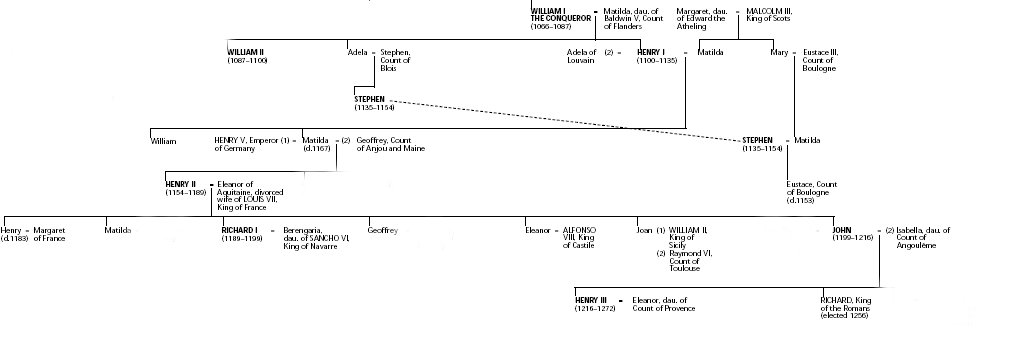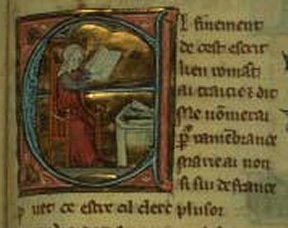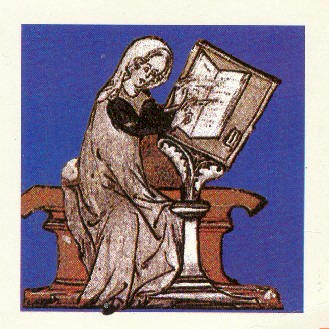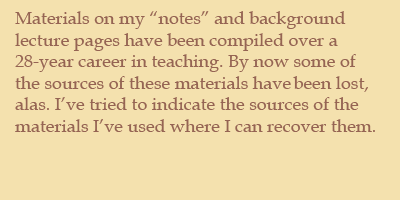


Marie de France
(late 12th c.)·
earliest French woman poet, probably active in England·
perhaps a half sister of Henry II ((r. 1154-1189); she is surmised by many to be Marie, daughter of Geofrey IV "Plantagenet" of Anjou, and the father of the Angevin line of the British monarchy


(Source for most of the genealogy is
http://www.royal.gov.uk/files/pdf/continen.pdf, with help from
http://www.mathematical.com/francemarie1145.html and
http://home.austarnet.com.au/dfgoonan/AQUITAINE.htm)
· lai, poetic and musical form popular among
the poets (trouvères) of northern France; long poems with rhymed stanzas of
6-16 lines, 4-8 syllables/line. Marie's are octosyllabic
(8 syllables pre line)
·
Breton lai (or lay) short, rhymed romance supposedly practiced by Breton storytellers; often include elements of the supernatural, chivalry, influence of classical and Celtic mythology (land of faerie). Marie's Breton lai was a short romance, between one hundred and a thousand lines, unlike the courtly romances which stretched to several thousand lines.·
Lais of Marie de France (c. 1160), twelve verse narratives in French (Anglo-Norman) language; octosyllabic couplets; dedicated to the "noble" king (likely Henry II)Marie de France's identity remains obscure, but it is clear that she was a woman of French origin writing in England in the later decades of the twelfth century, widely educated, and in touch with the royal court. She dedicates her book of Lais to a "noble King" who was probably Henry II, and she may have been his kinswoman, possibly an illegitimate half-sister. Marie's works draw into that courtly culture the languages and traditions of the English and Celtic past. She rewrote a Latin narrative about the origin of "Saint Patrick's Purgatory" and the adventure of an Irish knight there; and she retold the fables of Aesop using an English translation that she attributed to King Alfred. The Lais, she says, came to her through oral transmission, and she connects them with the Bretons.
A brief summary of her possible biographical identities:
Whereas the English poet Denis Piramus (Vie Seint Edmund le rei, after 1170) refers to her as “dame Marie,” emphasizing her noble rank, the scholar Claude Fauchet was the first to coin the name “Marie de France” in his Reueil de l’origine de la langue et poésie françoise (1581). Both the historical circumstances of the manuscripts containing her texts, and linguistic elements of Anglo-Norman, suggest that she lived in England during her adult life, but it seems most likely that she was born in France, probably in the Bretagne.
- She might have been Marie (I), the abbess of Shaftesbury, illegitimate daughter of Geoffrey IV Plantagenet of Anjou, because our poet translated from English into French a collection of fables (Fables) on the basis of those that King Alfred had allegedly translated from Latin into English, though no such adaptation is known today. The convent of Shaftesbury had been founded by Alfred. This abbess Marie, who was also the half-sister of King Henry II (1133-1189), served in her office from 1181 until at least 1215.
- Marie (II), the abbess of Reading, would be a second option as the Harley manuscript that contains both Marie’s fables and the lais (today housed in the British Library, MS Harley 978) might have been copied at her convent.
- Marie (III), the eighth child of Waleran II, Count of Meulan, is the third option, as she was brought up in the modern-day French département of Eure wherein is located the town of Pitres. Pitres is mentioned in Marie’s lai “Les Deus Amanz.” This Marie married Hugh Talbot, Baron of Cleuville who had extensive land holdings in Herefordshire which plays an important role in many of Marie’s lais.
- The fourth option might be Marie (IV), Countess of Boulogne, daughter of King Stephen of England and Marie de Boulogne. This Countess was raised in a convent and later gained the rank of Abbess of Romsey in Hampshire. King Henry II forced her to marry Matthew of Flanders as he wanted to maintain his power over Boulogne. Through her marriage Marie became the sister-in-law of Hervé II, son of Guiomar of Léon. The parallels between the names of Guiomar and Guigemar, the eponymous hero in one of Marie’s lais, are intriguing, yet not completely compelling. Marie de Boulogne returned to a convent sometime between 1168 and 1180, most likely to the convent of Sainte Austreberthe in Montreuil-sur-Mer.
None of these four associations with a historically identifiable person are fully convincing, and our Marie might well have been quite a different person otherwise not documented.
Marie de France may be trying less to propound a critique of the received stories of Arthur than to recall her readers' attention to elements that tradition has left aside, as she suggests in her prologue. Some of this is no more troubling than a delightful fantasy of wealth and pleasure, outside time and without consequences. Other elements imply, with startling economy, forces that (in the hands of later romancers) tear the Arthurian world to pieces. Writing a generation after Geoffrey of Monmouth and not long before Gerald of Wales, Marie brings a quite different and rather critical set of preoccupations to her Arthurian story. She opens her tale with a realistic and admirable occasion of male power and strong kingship: Arthur's battle for territory and his reward of faithful vassals. A bleaker side of that courtly world, and perhaps of Marie's own, is also implicit, however. With a terseness and indirection typical of her lais, Marie shows women as property in the king's gift, knights forgotten when their wealth runs out, and the perversion of judicial process. It’s worth comparing the world of Lanval with what is seen in Old English poetry of the relation of lord and retainers, and the connections between men and women.
Marvels and erotic desire dominate her tale, though, and women's power, for good or ill, is its primary motivating force. Guinevere, in a hostile portrait of adulterous aggression and vengeful dishonesty, manages to manipulate Arthur and his legal codes when Lanval rejects her advances. The queen is countered by Lanval's supernatural mistress, who commands luxurious riches that dwarf Arthur's; she rescues Lanval by being an unimpeachable legal witness in his defense. Indeed, she arrives on her white palfrey as the moment of judgment nears, almost like a knightly champion in a trial by battle. In a total reversal of convention, once she frees her love, she rides off with him into the sunset—only it’s the man on the back of the horse. Lanval vanishes into a timeless world of fulfilled desire and limitless wealth that has analogies in much older Celtic tradition. This closing scene defies the reintegration of male courtly order that is typical even in the erotic romances of Marie's contemporary Chrétien de Troyes.
The realm of eroticism and women's power in Lanval, though, is not automatically any more virtuous or stable than the ostentatious wealth and corruptible law of the world of Arthurian men. If Lanval's mysterious lady is beautiful and generous, she also takes his knightliness from him. Lanval is last seen riding behind the lady, and not on a warhorse but on a palfrey. Guinevere swiftly reduces Arthur to a weak and temporizing king. And in her initial explosion after Lanval rejects her, Guinevere accuses him of homosexuality. For all its absurdity, the moment articulates unnerving implications of the profound bonds among men in the Arthurian world, implications that could interrupt genealogical transmission of wealth and power. Marie's Guinevere again voices fears the tradition has left unsaid.
This is only one of Marie’s dozen lais; the others in her collection (including one on the Tristan legend) view love from other points of view, rendering a very kaleidoscopic picture of the relationships of men and women, of individuals and society, and of power and authority in her time.
We have several manuscript pictures that purport to be Marie writing. Since these manuscripts were copied after her death, they probably are not "portraits" in the modern sense, but they give you a sense of how her near-contemporaries thought she looked....



Sources: http://occawlonline.pearsoned.com/bookbind/pubbooks/damrosch_awl/chapter2/medialib/defrance.html
http://www.litencyc.com/php/speople.php?rec=true&UID=5494
http://mockingbird.creighton.edu/english/fajardo/teaching/eng340/marie_de_france.htm
If you want to read two of Marie's Fables, which seem to anticipate Chaucer's fabliaux, you can find them on the Harvard Chaucer pages at http://www.courses.fas.harvard.edu/~chaucer/special/litsubs/fabliaux/mari-fab.html
First set of bullet points adapted from http://gondolin.hist.liv.ac.uk/~azaroth/university/orfeo/node13.html
